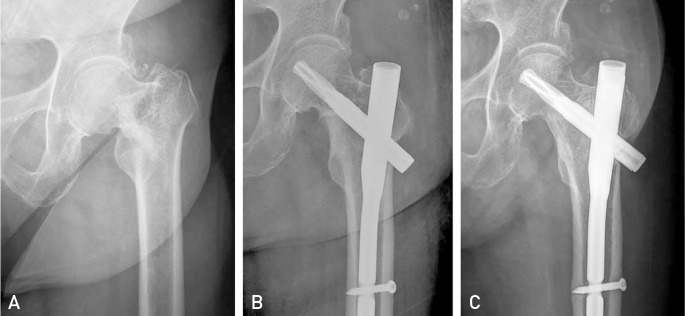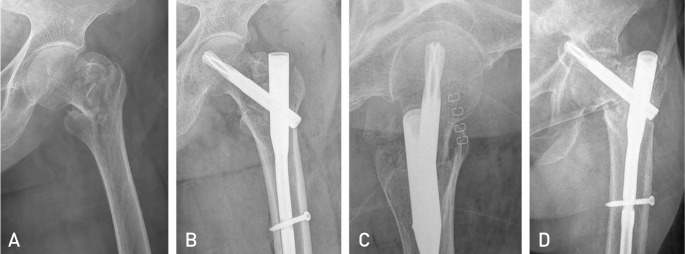Hip Pelvis.
2019 Dec;31(4):200-205. 10.5371/hp.2019.31.4.200.
Outcomes of Combined Neck and Trochanter Fractures of the Femur Treated with Cephallomedullary Nail in Elderly
- Affiliations
-
- 1Department of Orthopaedic Surgery, Daegu Fatima Hospital, Daegu, Korea. femur1973@gmail.com
- KMID: 2464236
- DOI: http://doi.org/10.5371/hp.2019.31.4.200
Abstract
- PURPOSE
Proximal femur fractures are classified into intracapsular neck fractures and extracapsular trochanteric fractures, and several related treatment recommendations in elderly patients have already been introduced. Importantly, we have observed cases of combined intra and extracapsular fractures (i.e., ipsilateral neck and trochanter fractures). The purpose of this study is to report the outcomes of combined neck and trochanter fractures of the femur treated with cephalomedullary nail (CMN) in elderly patients.
MATERIALS AND METHODS
From January 2010 to December 2014, 410 patients with proximal femoral fractures were fixed using CMN; among this group, 37 patients with combined neck and trochanter fractures were identified. Two of these patients died fewer than three months after injury and another two did not return for follow-up. Thirty-three patients were included and reviewed retrospectively in this study.
RESULTS
All patients were injured by simple fall. Bone union was obtained in 28 of 33 patients. Of the five patients who failed treatment, three experienced implant penetration through head (cut-through and cut-out), one had breakage of CMN and the last one had a loosening of internal fixation device with persistent non-union at final follow-up. The former four patients underwent hip replacement surgery and the latter refused surgery because he had low demand in daily life and many medical problems.
CONCLUSION
Eighty-five percent of elderly patients with combined neck and trochanter fractures of the femur treated with CMN achieved bone union; these complex fractures require more accurate reduction than usual extra-articular intertrochanteric fractures.
MeSH Terms
Figure
Reference
-
1. Lee YK, Kim JW, Lee MH, Moon KH, Koo KH. Trend in the age-adjusted incidence of hip fractures in South Korea: systematic review. Clin Orthop Surg. 2017; 9:420–423. PMID: 29201294.
Article2. Chen CY, Chiu FY, Chen CM, Huang CK, Chen WM, Chen TH. Surgical treatment of basicervical fractures of femur--a prospective evaluation of 269 patients. J Trauma. 2008; 64:427–429. PMID: 18301209.
Article3. Cobelli NJ, Sadler AH. Ender rod versus compression screw fixation of hip fractures. Clin Orthop Relat Res. 1985; (201):123–128.
Article4. Palm H, Jacobsen S, Sonne-Holm S, Gebuhr P. Hip Fracture Study Group. Integrity of the lateral femoral wall in intertrochanteric hip fractures: an important predictor of a reoperation. J Bone Joint Surg Am. 2007; 89:470–475. PMID: 17332094.5. Kim YS, Hur JS, Hwang KT, Choi IY, Kim YH. The comparison of compression hip screw and bipolar hemiarthroplasty for the treatment of AO type A2 intertrochanteric fractures. Hip Pelvis. 2014; 26:99–106. PMID: 27536566.
Article6. Chu X, Liu F, Huang J, Chen L, Li J, Tong P. Good short-term outcome of arthroplasty with Wagner SL implants for unstable intertrochanteric osteoporotic fractures. J Arthroplasty. 2014; 29:605–608. PMID: 23993736.
Article7. Chan KC, Gill GS. Cemented hemiarthroplasties for elderly patients with intertrochanteric fractures. Clin Orthop Relat Res. 2000; (371):206–215.
Article8. Rodop O, Kiral A, Kaplan H, Akmaz I. Primary bipolar hemiprosthesis for unstable intertrochanteric fractures. Int Orthop. 2002; 26:233–237. PMID: 12185526.
Article9. Babst R, Renner N, Biedermann M, et al. Clinical results using the trochanter stabilizing plate (TSP): the modular extension of the dynamic hip screw (DHS) for internal fixation of selected unstable intertrochanteric fractures. J Orthop Trauma. 1998; 12:392–399. PMID: 9715446.
Article10. Gupta RK, Sangwan K, Kamboj P, Punia SS, Walecha P. Unstable trochanteric fractures: the role of lateral wall reconstruction. Int Orthop. 2010; 34:125–129. PMID: 19288102.
Article11. Radford PJ, Needoff M, Webb JK. A prospective randomised comparison of the dynamic hip screw and the gamma locking nail. J Bone Joint Surg Br. 1993; 75:789–793. PMID: 8376441.
Article12. Papasimos S, Koutsojannis CM, Panagopoulos A, Megas P, Lambiris E. A randomised comparison of AMBI, TGN and PFN for treatment of unstable trochanteric fractures. Arch Orthop Trauma Surg. 2005; 125:462–468. PMID: 16059696.
Article13. Isaacs C, Lawrence B. Concomitant ipsilateral intertrochanteric and subcapital fracture of the hip. J Orthop Trauma. 1993; 7:146–148. PMID: 8459300.
Article14. Kumar R, Khan R, Moholkar K, Smyth H, Borton D. A rare combination fracture of the neck of femur. Eur J Orthop Surg Traumatol. 2001; 11:59–61.
Article15. Perry DC, Scott SJ. Concomitant ipsilateral intracapsular and extracapsular femoral neck fracture: a case report. J Med Case Rep. 2008; 2:68. PMID: 18312634.
Article16. Baumgaertner MR, Curtin SL, Lindskog DM, Keggi JM. The value of the tip-apex distance in predicting failure of fixation of peritrochanteric fractures of the hip. J Bone Joint Surg Am. 1995; 77:1058–1064. PMID: 7608228.
Article17. Saarenpää I, Partanen J, Jalovaara P. Basicervical fracture--a rare type of hip fracture. Arch Orthop Trauma Surg. 2002; 122:69–72. PMID: 11880905.18. Watson ST, Schaller TM, Tanner SL, Adams JD, Jeray KJ. Outcomes of low-energy basicervical proximal femoral fractures treated with cephalomedullary fixation. J Bone Joint Surg Am. 2016; 98:1097–1102. PMID: 27385683.
Article19. Kweon SH, Lee SH, Kook SH, Choi YC. Outcomes of cephalomedullary nailing in basicervical fracture. Hip Pelvis. 2017; 29:270–276. PMID: 29250502.
Article20. Tasylkan L, Ugutmen E, Sanel S, Soylemez MS, Ozkan K, Solakoglu C. Short-term results of surgical treatment with cephalomedullary nails for basicervical proximal femoral fractures. Acta Orthop Belg. 2015; 81:427–434. PMID: 26435237.21. Sawaguchi T, Sakagoshi D, Shima Y, Ito T, Goldhahn S. Do design adaptations of a trochanteric nail make sense for Asian patients? Results of a multicenter study of the PFNA-II in Japan. Injury. 2014; 45:1624–1631. PMID: 24985469.
Article22. Li J, Cheng L, Jing J. The Asia proximal femoral nail antirotation versus the standard proximal femoral antirotation nail for unstable intertrochanteric fractures in elderly Chinese patients. Orthop Traumatol Surg Res. 2015; 101:143–146. PMID: 25701162.
Article
- Full Text Links
- Actions
-
Cited
- CITED
-
- Close
- Share
- Similar articles
-
- Unstable Intertrochanteric Fracture Treated with ITST: A Comparative Study between Groups with and without Comminution of Greater Trochanter
- Structural Study of Proximal femur in the Elderly Femoral Neck & Trochanteric Fracture
- Treatment of Intertrochanteric Fracture of Femur: A Randomized Prospective Comparative Analysis of the Internal Fixation of Gamma Nail and Compression Hip Screw
- Bilateral Femoral Neck Fractures in a Young Adult: A Case Report
- Clinical and Radiological Outcomes of Unstable Intertrochanteric Fractures Treated with Trochanteric Fixation Nail-Advanced and Proximal Femoral Nail Antirotation-II: Correlation between Lateral Sliding of the Helical Blade and Lateral Trochanteric Pain




